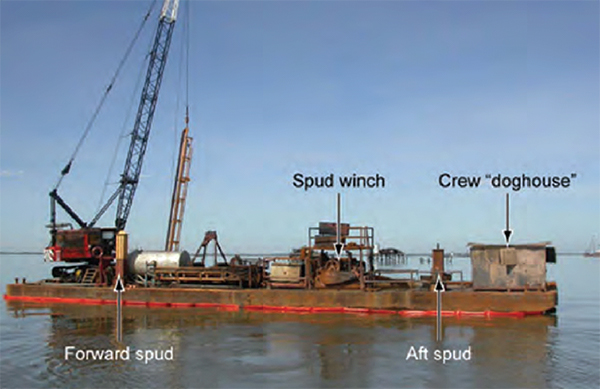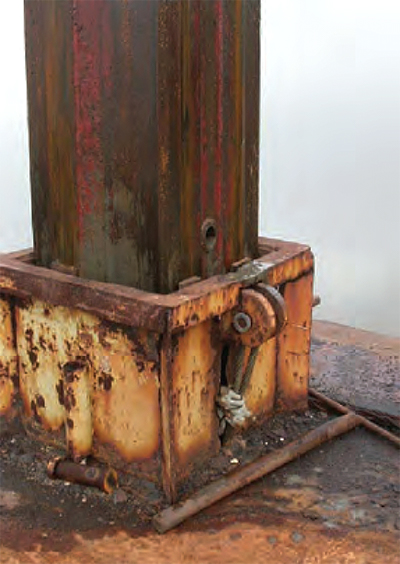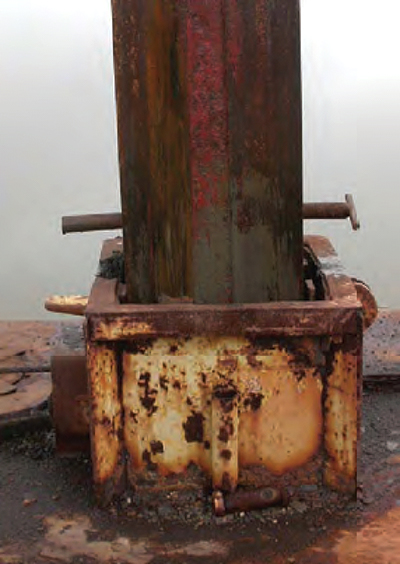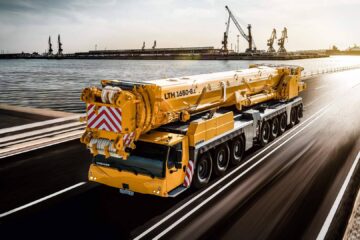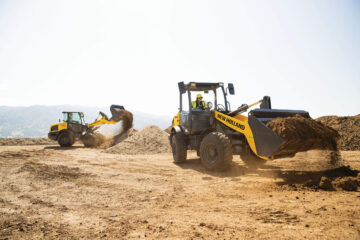During marine construction work deck barges are held in place by vertical steel shafts known as spuds. The spud equipment typically consists of forward and aft spuds and a diesel engine-powered spud winch. Three methods are available to prevent the spud from accidentally dropping or slipping: latching the winch foot brake; engaging a steel pawl that fits into a notched ring on the outside of the winch drum; and inserting a steel securing pin directly through the fully raised spud, preventing it from free-falling if the winch or cable fails.
Photos showing spud with securing pin lying alongside (left) and with securing pin inserted (right).
Fire aboard the Athena 106, West Cote Blanche Bay, Louisiana
On October 12, 2006, the towing vessel Miss Megan was pushing two deck barges to a pile-driving location in the West Cote Blanche Bay oil field off the Louisiana coast. While the vessels were underway, the 5-ton aft spud on one of the barges, the Athena 106, suddenly dropped into the water from its raised position. The spud struck a buried high-pressure natural gas pipeline, rupturing the pipeline. The gas ignited and created a fireball that engulfed the towing vessel and both barges. The master of the towing vessel and four barge employees were killed, and another barge employee was listed as missing.
The Athena 106 accident investigation found that in day-to-day operations the spud winch operator used only foot brakes to hold the raised spuds. The accident could have been prevented if the securing pin had been used as a backup to the winch foot brakes to hold the raised spud. The securing pin would have kept the spud from accidentally deploying, even if the winch, its brakes, or the supporting cable failed.
Preventing Accidental Deployment of Spuds
To ensure the safety of employees on construction barges and towing vessels, employers and employees need to take the following safety precautions:
• Before a barge is moved, the spuds need to be raised so that the pinhole is above the resting area of the securing pin. Each spud should be pinned in the raised position.
• The licensed master of a towing vessel, who is responsible for ensuring that the vessels under his or her control are safe to move, needs to ensure that spud securing pins are in place and have a means to prevent inadvertent disengagement before the tow is underway.
• If the spuds must be lowered to stop the barge in an emergency situation (for example, in case of a power failure of the tug or an imminent collision), a supervisor needs to direct the barge employees on how to lower the spuds.
Before attempting to lower mooring spuds, ensure that spud securing pins are completely removed and that employees are clear of the immediate area. Such practices will help to avoid employees being struck by dislodged or falling pins, which can weigh up to 85 pounds and measure approximately 4-feet-long and 3 inches in diameter.
• Employers who own and operate barges need to develop standard operating procedures. Employers should provide periodic training to employees on barges including, how to use securing pins to hold spuds safely in place before a barge is moved from one site to another.






